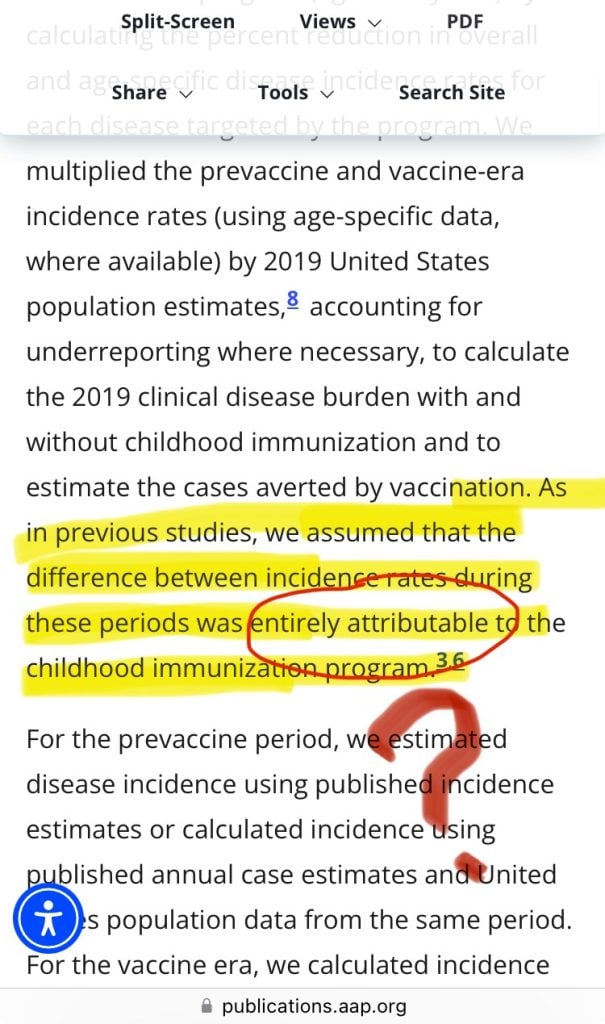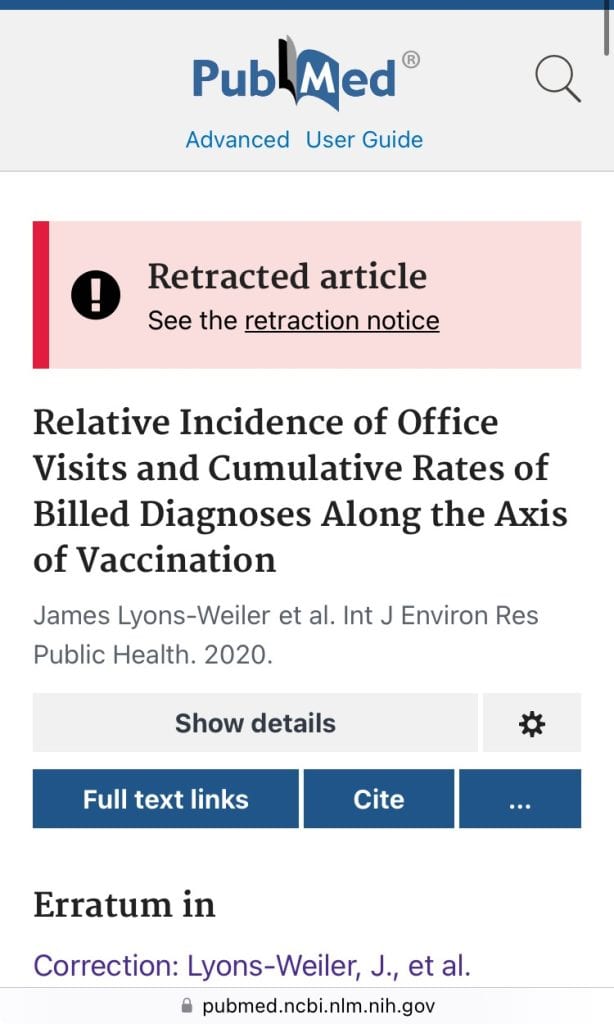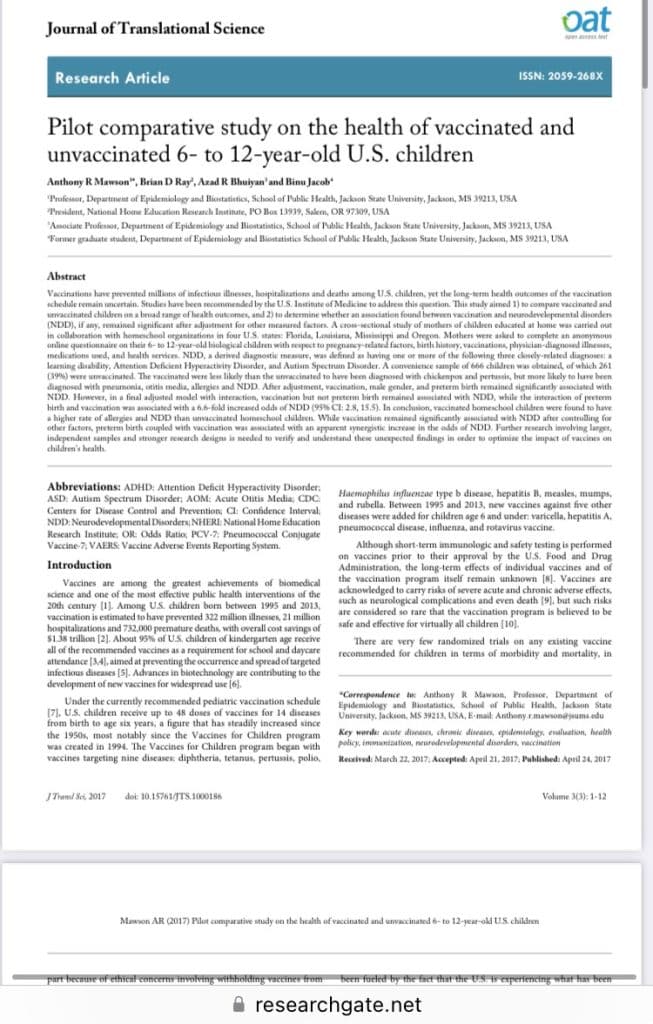In the United States, we have an ever-growing childhood vaccine schedule. And that schedule is administered following a one-size-fits-all approach. Most any pediatrician will tell you that vaccines are a necessary component for protecting your child’s health. Some will even kick patients out of their practice entirely for not following the prescribed schedule. With so much gusto and support for the childhood schedule, surely it has been studied down to the tiniest detail and deemed critical for our children to achieve the best possible health outcomes, right? Well…not so fast. Let’s take a look at the available research comparing the vaccinated and the unvaccinated children. It might surprise you!
What Are We Looking For in These Comparative Studies?
what are we looking for in these comparative studies? Short answer: We are looking for OVERALL health outcomes. Not just vaccine-preventable disease outcomes.
But first, let’s clarify what we mean by OVERALL health outcomes. Limited scope studies, like this one published in the journal Pediatrics, have found a reduction in vaccine-preventable diseases among vaccinated children. So, for example, children who get the Measle-Mumps-Rubella (MMR) vaccine are less likely to contract Measles. Okay, great. And children who get the Rotavirus vaccine are less likely to contract Rotavirus. Okay, wonderful. But now the obvious question…AT WHAT COST?
Hold that thought. Before we talk about that cost, let’s address a HUGE assumption these types of studies have made. In the “Methods” section of the Pediatrics paper, it clearly states that, “we assumed that the difference between incidence rates during these periods was entirely attributable to the childhood immunization program.” And they explain that they got their numbers for pre-vaccine infection rate from the final 5 years before the before the vaccine was licensed and administered. In the case of the Diphtheria vaccine, Table 1 indicates that it was licensed in 1928. So, they compared current diphtheria rates to the rates from approximately 1922-1927?! That was 100 years ago! Is it sensible to assume that the ONLY factor that has changed for American children in the last 100 years is the availability of this vaccine? No! What about sanitation practices? Indoor plumbing? Availability of a variety of fruits and vegetables? Refrigeration? Availability of vitamins, supplements, and natural remedies? Availability of healthcare? Standard of living?
I could go on, but clearly, American children live very different lives now than they did 100 years ago.

From Pediatrics, August 2022 article titled “Impact of Routine Childhood Immunization in Reducing Vaccine-Preventable Diseases” in the United States
Now, back to the cost. Let’s play along with Pediatrics and ASSUME that the decrease in cases of measles can be ENTIRELY attributed to the vaccine. What does the benefit of skipping a measles infection cost our children? Some experts says that the adjuvants and additives in our vaccines are responsible, at least in part, for the rise of chronic disease among our children. The CDC confirms that, “In the United States, more than 40% of school-aged children and adolescents have at least one chronic health condition, such as asthma, obesity, other physical conditions, and behavior/learning problems.” (source) So, IF I’m trading a typically mild, short-lived disease like measles for a chronic, life-long disease like asthma or an auto-immune disorder, I’d really like to know.
Broader Questions Can Paint a Clearer Picture
When we ask broader questions, we begin to see the whole health picture. And the big picture is much more valuable than only zeroing in on a handful of diseases and measuring them against crazy benchmarks like disease rates 100 years ago.
So, when we talk about OVERALL HEALTH OUTCOMES, we are wanting to find out statistics such as the following:
- How many hospital visits did Vaccinated Children vs Unvaccinated have in their lifetimes?
- How many prescription drugs were needed for each group to maintain health?
- What was the overall life expectancy for each group?
- How many children in each group were diagnosed with a chronic disease during childhood? During adulthood?
- How many office visits/ specialized doctors did each group need in their lifetimes?
To sum it up, studies like the one in Pediatrics are abundant. And they are used to shout the success of our nation’s vaccine program from the rooftops. But when you see one of these studies, remember to ask yourself the following:
- Were any other factors/variables at play that could have reduced the prevalence of this disease?
- What was the cost in terms of overall health outcomes for those that received the vaccine?
Large-Scale, Quality Studies on Vaccinated vs Unvaccinated Children
I’m going to get straight to the point here. There are exactly ZERO large-scale, quality studies on overall health outcomes for Vaccinated vs Unvaccinated Children. A 2013 report from the federal Institute of Medicine (IOM) called The Childhood Immunization Schedule and Safety: Stakeholder Concerns, Scientific Evidence and Future Studies confirmed that there were zero studies on the overall cumulative safety of the current vaccine schedule (See Recommendation 6-1 here). That’s right. They’ve never looked at the safety of giving all of those 72 recommended vaccines to a child.
And in Recommendation 6-2 they advise AGAINST doing a vaccinated vs unvaccinated study. They claim that it would be unethical to withhold vaccines from young children They also make some arguments against studying a partial or delayed vaccine schedule, citing extra time and burden for parents and doctors involved.
However, in the same report, under “Methodological Approaches”, they point out that data in the VSD (Vaccine Safety Datalink) is readily available for such a study. They further explain that health records for about 9 million children and adults with varying vaccination status are contained in the VSD. The report says, “The most feasible approach to studying the safety of the childhood immunization schedule is through analyses of data obtained by VSD.” In other words, they already have the data they need to do a large-scale study with a fantastic sample size. They could proceed tomorrow without any concerns of being unethical.
From IOM’s 2013 report
And in 2016, The CDC (Center for Disease Control) published its White Paper on Safety of Childhood Vaccination Schedule, which further confirmed the VSD as a feasible source of information for such a study. They also acknowledged that stakeholders have a desire to get more information on this matter of public health. (Um, yes…we do desire more info!)
So Why Haven’t They Done a Vaccinated vs Unvaccinated Study?
As I’ve pointed out above, they’ve talked about the LACK of such a study. They’ve talked about the FEASIBILITY of such a study. They have all of the DATA NEEDED to do such a study. So, why haven’t they done it?
Many people think that they HAVE done such a study. The concern is that the results were so negatively conclusive that the results couldn’t be released to the public. They believe that if the results were positive and strongly favored vaccination promoting long term health, we’d hear about it. They point out that it would be at the top of the news for all pro-vaccine enthusiasts to use as a rallying cry.
Smaller, Observational Studies Available
In the absence of a high-powered study, there have been some attempts to do smaller, observational studies on this topic. However, without government funding and data, they have their limitations Still, they offer some insight. And at this point, they’re all we have to go by. Let’s look at the 3 available vaccinated vs unvaccinated studies.
Study #1: “Relative Incidence of Office Visits and Cumulative Rates of Billed Diagnoses Along the Axis of Vaccination” by James Lyons-Weiler and Paul Thomas, published in the International Journal of Environmental Research and Public Health in November of 2022 (later retracted by the journal).
- This study followed 3,234 patients from Dr. Paul Thomas’s pediatric practice (2,763 with varying numbers of vaccines and 561 completely unvaccinated).
- These patients had seen Dr. Thomas since birth.
- They looked for the number of sick-care office visits for both groups, as well as diagnosis of common chronic diseases.
- Results showed an increase in asthma, allergic rhinitis, anemia, sinusitis, and ADHD.
- They conclude that, “the overall results may indicate that the unvaccinated pediatric patients in this practice are healthier overall than the vaccinated.”
- They encourage other pediatric clinics around the world to conduct similar studies within their practices.
From the Weiler Study
Study #2: “Analysis of health outcomes in vaccinated and unvaccinated children: Developmental delays, asthma, ear infections and gastrointestinal disorders” by Brian S. Hooker and Neil Z. Miller., published in Sage Open Medicine in May 2020.
- They used medical records from 3 different medical practices in the United States. The study population included 4,821 patients.
- Patients were grouped by the number of vaccines they received in their first year of life.
- They found a higher percentage of cases of developmental delay, asthma, ear infection (otitis media), and gastrointestinal disorders in the fully vaccinated group.


From the Hooker study
Study #3: “Pilot comparative study on the health of vaccinated and unvaccinated 6- to 12- year old U.S. children” by Anthony R Mawson, Brian D Ray, Azad R Bhuiyan, and Binu Jacob, published in the Journal of Translational Science in April of 2017.
- The study involved 405 vaccinated homeschool children and 261 unvaccinated homeschool children (from the National Home Education Research Institute).
- The age group was limited to 6-12 years of age.
- Mothers were asked to fill out a questionnaire regarding 40 acute and chronic illnesses. They were asked to indicate which illnesses their children had received a diagnosis by a physician.
- Survey data indicated that vaccinated children were less likely to have chickenpox and pertussis than unvaccinated individuals. However, they were more likely to have otitis media, pneumonia, neurodevelopmental disorders (NDD- which included learning disabilities, ADHD and autism spectrum disorder), allergic rhinitis/hay fever, and eczema. They were also more likely to need antibiotics and ear tubes.
- The study authors also noted incremental increases in diagnoses based on vaccination rates of children (the more vaccines a child received, the more diagnoses they received).
From Mawson study
If They Won’t Do the Studies, Then What?
For various reasons, I’m not holding my breath for them to do additional research or provide any new information anytime soon. But that doesn’t mean that there isn’t other homework concerned parents can do on routine vaccinations.
I’ve got a list of 10 Questions to Ask Your Doctor or Health Care Provider about Vaccines that might be helpful. I also put together a list of legitimate, research-based, well-cited resources for any parent who wants to start educating herself on vaccines.
So, don’t wait. Let’s go!










